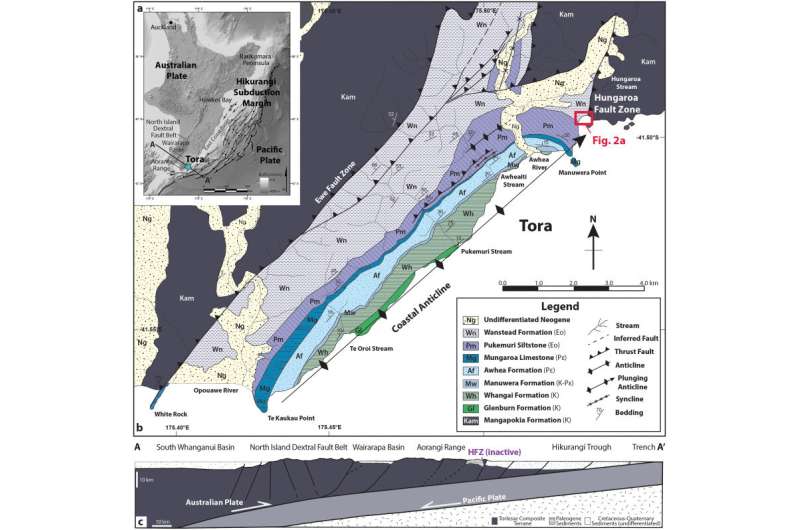Long-dead marine organisms may influence next major earthquake

Tiny creatures tens of millions of years old may affect the size of the next destructive earthquake in the Hikurangi subduction zone.
The subduction zone, New Zealand's largest fault, marks the boundary where the Pacific Plate is diving under the Australian plate. Huge "megathrust" earthquakes of more than magnitude 8 can be generated in the area.
Dr. Carolyn Boulton from Te Herenga Waka—Victoria University of Wellington has been leading a team of earthquake scientists studying a rocky bluff on the Hungaroa fault, located on the margins of the Hikurangi subduction zone.
Layers of limestone, mudstone, and siltstone on the bluff near Tora, about 35 km southeast of Martinborough, are a handy proxy for what's happening in the subduction zone offshore, Dr. Boulton says.
Similar rocks to those on the bluff were deposited on the seafloor between 35 and 65 million years ago but their location makes it difficult to study them. Instead, scientists can look at the rocks on land to tell them more about what's happening under the sea.
"The rocks all contain calcite from ancient single-celled marine organisms, mainly foraminifera, such as plankton. We've found calcite from those tiny organisms can affect movement in the subduction zone. Just think, these tiny, long-dead organisms can affect how two huge tectonic plates interact mechanically."
Dr. Boulton says if the calcite in the rocks is able to dissolve—like sugar in tea—the fault can be weak and slide easily without an earthquake. However, if the calcite can't dissolve, the fault can "lock up," storing energy that might be released in a large quake.
"Calcite dissolves faster when it's highly stressed and when temperatures are cooler. It dissolves more easily at low temperatures—say, room temperature. But it gets harder to dissolve as temperature goes up—say, deeper in the Earth.
"In the subduction zone, temperature increases more slowly than on land—by only around 10 ºC/km. So the fault is really sensitive to what calcite, those shells of old dead marine organisms, is doing.
"The amount and behavior of calcite from these organisms is a big piece of the puzzle of how large the next earthquake might be."
The Hikurangi subduction zone still holds a lot of mysteries for scientists to uncover, Dr. Boulton says.
"Geologists studying the Alpine Fault and other faults onshore can examine them up close. But seeing inside the Hikurangi subduction zone requires expensive drilling equipment. This means our record of previous large earthquakes in the area is not as good.
"Our observations from Tora show us the shallow part of the subduction zone can accommodate plate movements by slipping slowly—or by slipping quickly in large and damaging earthquakes.
"What we really want to know is: Are there slow-slip events out there we haven't detected? Are the rocks moving without earthquakes, or are they truly locked up? That will help tell us what might happen in the next earthquake," Dr. Boulton says.
A megathrust earthquake along the subduction zone could generate a large tsunami, evidence of which has been found in geological digs and the fossil record along the east coasts of both the North and South Islands, and through Cook Strait.
Scientists forecast there's a 26% chance of a large earthquake in the next 50 years on the southern margin of the Hikurangi subduction zone.
Results of the research are published in the journal Lithos.
More information: Carolyn Boulton et al, Observational and theoretical evidence for frictional-viscous flow at shallow crustal levels, Lithos (2022). DOI: 10.1016/j.lithos.2022.106831
Provided by Victoria University of Wellington




















